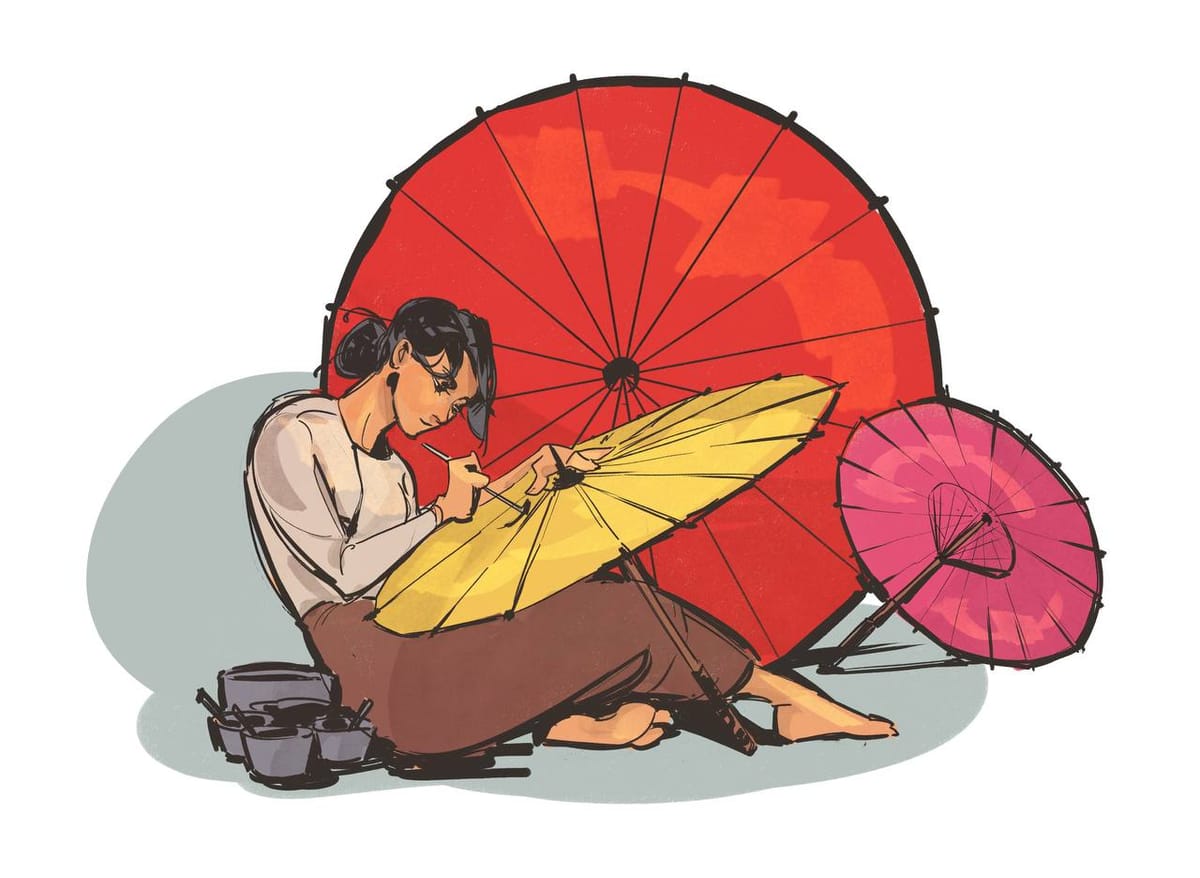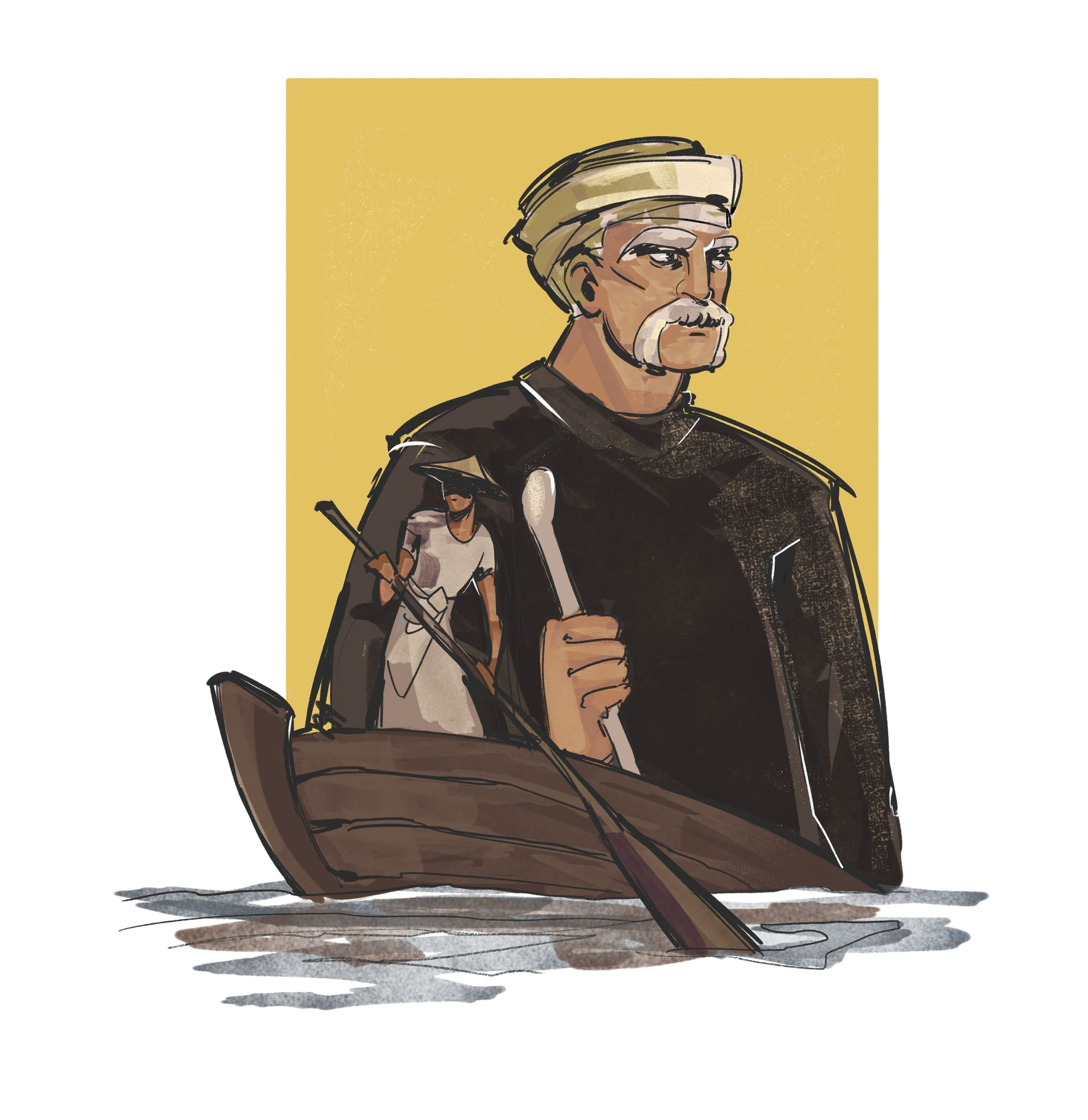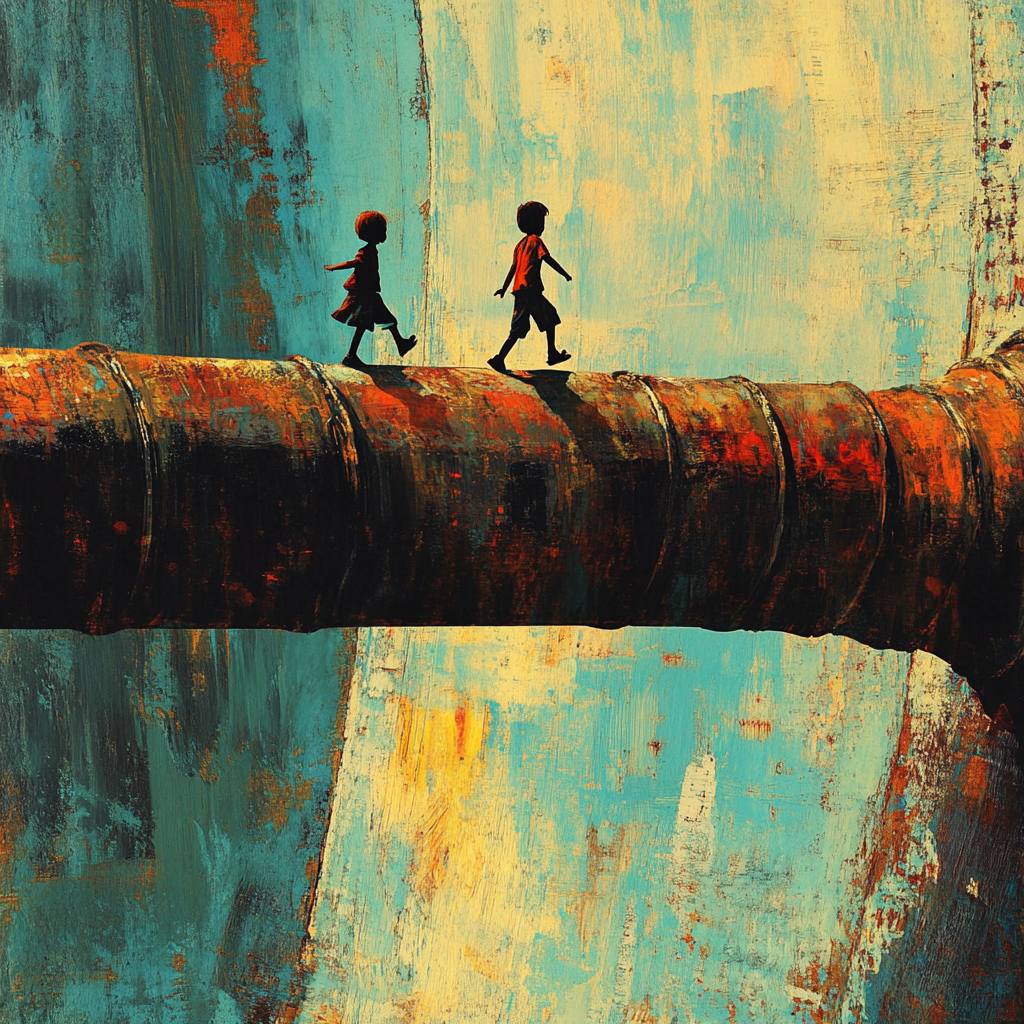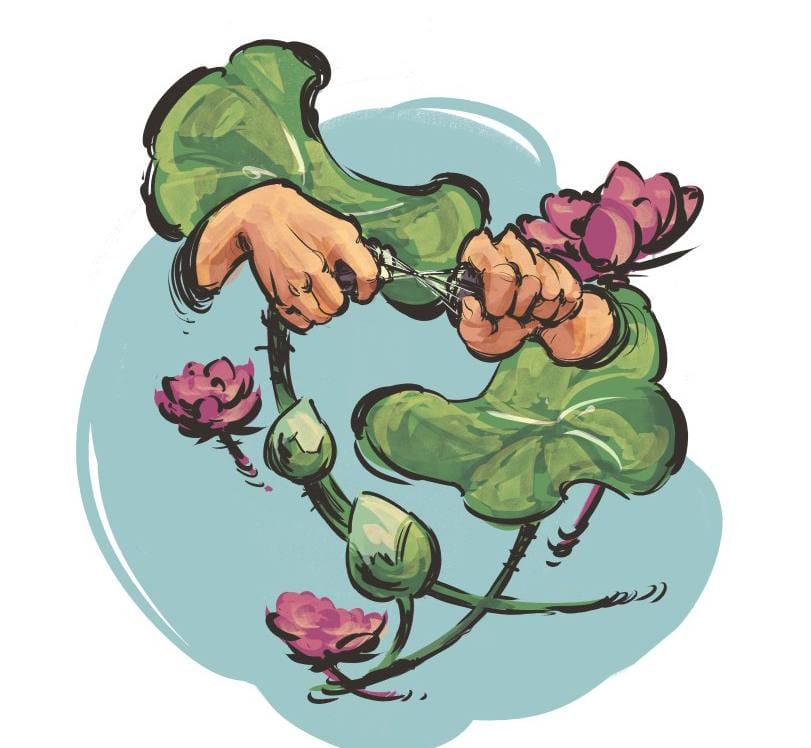
If King Thibaw had not been exiled, the Pathein umbrella would not have come into existence. Without this extraordinary piece of Myanmar handicraft, the Myanmar people would not have had the opportunity to possess such a proud heritage. The history of the country is intertwined with the history of the Pathein umbrella. This raises some questions.
What is a Pathein umbrella, and why is it called so? Who first invented the Pathein umbrella? How was the Pathein umbrella connected to King Thibaw?
The Myanmar Umbrella Tradition that Excluded Civilians
In fact, until King Thibaw's reign, Myanmar civilians were not allowed to use umbrellas. To understand this, we first need to grasp the traditional Myanmar umbrella custom.
In traditional Myanmar beliefs, an umbrella symbolizes worthiness of worship and represents power and authority, signifying a noble accessory. It was also believed that there was a celestial maiden guarding the umbrella. Therefore, umbrellas were not considered ordinary consumer goods.
From the Bagan era to the Konbaung period, throughout the feudal era, only kings, queens, princes, court officials, those honored by the king, and monks were allowed to use umbrellas. For example, white umbrellas were placed behind the king's throne, and white umbrellas were also used for monks' funerals.
As for ordinary civilians, they were not allowed to use umbrellas. It was considered improper, inappropriate, and unworthy for common people to use umbrellas. Civilians who were not allowed to use umbrellas used hats made of palm leaves instead.
This long-standing Myanmar umbrella tradition came to an end with the fall of the Myanmar monarchy. Here's how it happened. When King Thibaw was exiled in 1885, the craftsmen from the palace also had to leave. Once outside the palace and needing to make a living, they continued their crafts that they had practiced in the palace.
Among these craftsmen were royal umbrella artisans. They too had to make a living with the umbrella-making skills they had practiced in the palace.
Ten years after King Thibaw's exile, the Eindawya umbrella emerged. It was started by U Chit, a master royal umbrella artisan. It was called the Eindawya umbrella because it was made near the Eindawya Pagoda in Mandalay. The Eindawya umbrella was the first umbrella that ordinary civilians were allowed to use. It wasn't until after 1900 that the Pathein umbrella appeared.
The Origins of the Pathein Umbrella
After King Thibaw's exile, some of the palace craftsmen who had to leave stayed in Mandalay, while others went down to Lower Burma.
Among those who went to Lower Burma was U Shwe Sa, a royal umbrella artisan. In 1914, U Shwe Sa, along with about thirty others, arrived in Pathein. The reason for their journey was to visit King Thibaw, who was imprisoned in Ratnagiri. When the British learned of this, they tried to disrupt the plan to visit King Thibaw. They provided land for U Shwe Sa and his companions to settle in Myoma Kyaung Street in Pathein. They also allowed them to open umbrella workshops if they wanted to make umbrellas.
At that time, while the umbrella industry was thriving in Upper Burma, there are no records of an umbrella industry in Lower Burma. When they were persuaded to settle in Pathein, U Shwe Sa and his companions abandoned their plan to visit King Thibaw and settled in Pathein. For their livelihood, they continued the umbrella-making business.
This is how the Pathein umbrella came into existence. Although it was started by the royal umbrella master U Shwe Sa, it was called the Pathein umbrella, named after the region where it was produced, just like the Eindawya umbrella.
What Does It Take to Make a Pathein Umbrella?
The unique characteristic of the Pathein umbrella is that it is a genuine Myanmar handicraft, created entirely by hand from start to finish without the aid of machines. A Pathein umbrella goes through many stages of production. Each of these stages is crafted by hand, without machine assistance, following the same palace umbrella-making process from about a hundred years ago.
The main raw materials for a Pathein umbrella are wood and bamboo. For the umbrella ribs, locally grown Thara Khu bamboo is used. However, it's not enough for it to just be Thara Khu bamboo. The age of the bamboo must also be considered. Young bamboo is prone to insect infestation. Bamboo that is 9 years old is in the best condition for making umbrella ribs.
For the umbrella crown and handle, Ma Tu Shwe Wa wood is used. For the umbrella canopy, cotton, silk, or cloth is used. To attach the canopy to the ribs, a paste made from ground Palawpinan yam mixed with water is used as glue.
After attaching the canopy to the ribs, cotton thread or wool is used to weave and tie the umbrella crown and top to keep them secure. The opening and closing mechanism of the umbrella is also made of wood, without using any metal or springs. Once the umbrella body is complete and the canopy is painted, a Pathein umbrella is ready.
These are the basic steps to create a Pathein umbrella. This process involves many detailed steps that need to be carried out meticulously.
In the past, Pathein umbrellas could only be used in summer and winter. Nowadays, waterproofing techniques are being used to make them usable during the rainy season as well. For waterproofing, the umbrella canopy is coated with a mixture of resin from the Thit Say tree and sesame oil.
Looking at the production process and raw materials of the Pathein umbrella, you can see that only natural materials are used. Because it's based on bamboo and wood, another unique feature of the Pathein umbrella is that the canopy slightly curves when it's cold and spreads out into a perfect circle when it's hot.
The Current State of the Pathein Umbrella
The Pathein umbrella was once a popular and fashionable accessory among Myanmar women. It was even featured in songs.
Later, when foreign-made umbrellas with metal ribs and silk or polyester canopies entered the market, the popularity of the Pathein umbrella declined. The fact that it couldn't be easily folded and wasn't as portable became disadvantages when compared to foreign-made umbrellas. Today, the tradition of using Pathein umbrellas can only be seen in donation processions and pagoda festivals.
These are the changes in the Pathein umbrella's status from the consumers' perspective. On the production side, there are also challenges.
The first issue is the raw material problem. Although there are bamboo forests in the Ayeyarwady delta region, only Thara Khu bamboo, which grows specifically around Pathein, is the best bamboo for Pathein umbrellas. This has led to a raw material problem. Currently, the depletion of Thara Khu bamboo forests has reached a concerning level. There is no sustainable cultivation method for this, nor are there techniques for raw material conservation.
The second issue is the scarcity of Pathein umbrella artisans and workers. This heritage craft, which needs to be passed down through generations, is nearing a generational gap. The art of making Pathein umbrellas is intricate and requires skilled craftsmanship. It takes a considerable amount of time to master. Therefore, when compared to skills that can be learned quickly and generate income faster, it has fallen behind. The fact that other occupations offer more stable and lucrative income than the Pathein umbrella industry is also a reason for the scarcity of the next generation of artisans.
The final issue is the market. Before the COVID-19 pandemic, the Pathein umbrella market was quite robust. Although not used as frequently as common umbrellas, there was high domestic demand for donation ceremonies, religious festivals, and local festivals. Pathein umbrellas were also used for decoration, so hotels, restaurants, guesthouses, and companies were frequent buyers.
There was strong purchasing by tourists as souvenirs to take home, and there were even tour programs to study the Pathein umbrella-making process. Myanmar's Pathein umbrellas were more durable than traditional umbrellas from other countries, so they sold well not only in the domestic market but also in foreign markets.
When the tourism sector declined during the COVID-19 pandemic, there was a slowdown in business, but the market didn't completely collapse. Pathein umbrella business owners say that the business was operating smoothly until around 2020.
After the military coup, however, the Pathein umbrella market has nearly collapsed due to raw material shortages, the halt of the tourism sector, and the complete cessation of demand from previously regular buyers in Mandalay, Naypyidaw, Yangon, Bagan, Nyaung-U, and foreign markets.
With the Pathein umbrella market on the brink of total collapse, it has created difficulties for the long-term sustainability of key Pathein umbrella weavers, umbrella frame makers, Pathein umbrella painters, and Thara Khu bamboo growers and producers.
Now, only large businesses like Shwe Sa Pathein Umbrella can withstand the situation, while small-scale producers are stopping their Pathein umbrella businesses and switching to other occupations.
Those who are still in the business are trying to preserve the traditional heritage and are struggling to maintain the hereditary business despite all the challenges they face.
After 2021, although the state has repeatedly called for increased production of local products, no practical assistance or support has been seen yet.
The small Taw Ya Kyaung Street ward in Pathein city, the main source of Myanmar's heritage handicraft, the Pathein umbrella, is now helpless and barely surviving. Among the closed Pathein umbrella workshops, colorful Pathein umbrellas drying in the sun can be seen here and there, scattered and broken. Whether this is the last breath of the Pathein umbrella remains to be seen.
Nu Thet Moe (Y3A)
 Build Myanmar - MediaY3A
Build Myanmar - MediaY3A
 Build Myanmar - MediaY3A
Build Myanmar - MediaY3A
 Build Myanmar - MediaY3A
Build Myanmar - MediaY3A
Build Myanmar-Media : Insights | Empowering Myanmar Youth, Culture, and Innovation
Build Myanmar-Media Insights brings you in-depth articles that cover the intersection of Myanmar’s rich culture, youth empowerment, and the latest developments in technology and business.
Sign up for Build Myanmar - Media
Myanmar's leading Media Brand focusing on rebuilding Myanmar. We cover emerging tech, youth development and market insights.
No spam. Unsubscribe anytime.
Sign up now to get the latest insights directly to your mailbox from the Myanmar's No.1 Tech and Business media source.
📅 New content every week, featuring stories that connect Myanmar’s heritage with its future.
📰 Explore more:
- Website: https://www.buildmyanmarmedia.com/
- Facebook: https://www.facebook.com/buildmyanmar
- YouTube: https://youtube.com/@buildmyanmarmedia
- Telegram: https://t.me/+6_0G6CLwrwMwZTIx
- Inquiry: info@buildmyanmar.org
#BuildMyanmarNews #DailyNewsMyanmar #MyanmarUpdates #MyanmarNews #BuildMyanmarMedia #MyanmarNews #GlobalNews #TechNewsMyanmar #BusinessNewsMyanmar #Updates #Insights #Media
